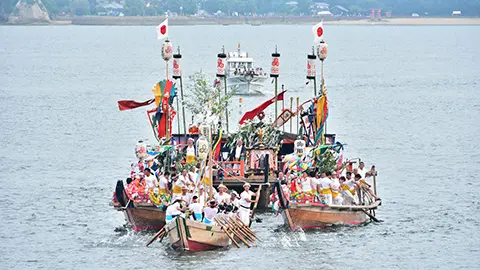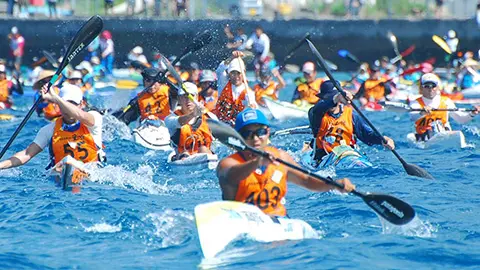VOL.193 JUNE 2024
SUMMER FUN IN JAPAN: SEASIDE FESTIVALS AND EVENTS
A Mikoshi Crosses the Sea with Prayers for A Good Catch and Safety at Sea
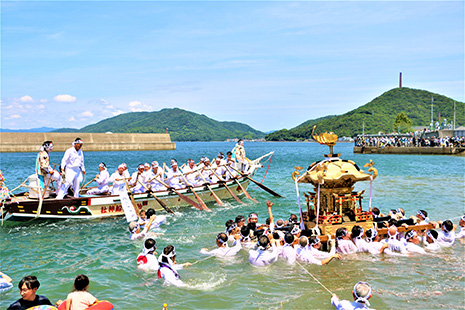
Photo: Tokuyama Plant, Nippon Seiro Co., Ltd.

Photo: Sukumojima City Center
Yamaguchi Prefecture is located at the westernmost tip of Japan’s main island of Honshu. Surrounded by sea on three sides, it is characterized by its abundant nature and mild climate. Sukumo Island in Shunan City, situated in the southeastern part of the prefecture, has a festival in which a mikoshi* (portable shrine) is carried across the sea. We interviewed a person in charge of this festival at the Sukumojima City Center.
Sukumo Island is at the tip of the Oshima Peninsula in Shunan City. This island is the birthplace of longline fishing for pufferfish (haenawa ryo**) and is known for a rite in which a mikoshi portable shrine is carried across the sea as a part of the summer festival at Kifune Shrine, *** which is located at the northern tip of the island. The island has a circumference of 3.7 km, and only about 250 people reside there. However, the festival, which is held every year on a late-July or early-August Sunday, teems with tourists in the summer.
TAKAMATSU Marina, a staff of the Sukumojima City Center says, “The details of this festival’s origin of Kifune Shrine on Sukumo Island are not clear, but the story handed down says that the festival began as a summer festival of Kifune Shrine about 300 years ago, when the fishing industry was thriving, to pray for good catches and safety at sea. The current practice of mikoshi crossing the sea accompanied by boats was adopted about 150 years ago. This was said to have been done at the suggestion of a local shipping company. About 40 men dressed in white, who have purified themselves, carry the roughly 600 kg mikoshi from Kifune Shrine into the sea shouting “chosayoi” **** and then swim and carry up it across about 500 meters to the opposite shore. The crossing takes about one hour.
Another highlight of the festival, TAKAMATSU explains, is the small tenmasen boat that guides the mikoshi. “At the bow of the boat is a dancer holding a bundle of colored paper called a bonden, and at the stern are two dancers who hold oars about 1 m long as they dance. It is said that these dancers and their calls of hohran’ei serve to lead the mikoshi carrying the spirits of the deities in a resplendent way, inspiring the 16 rowers.”
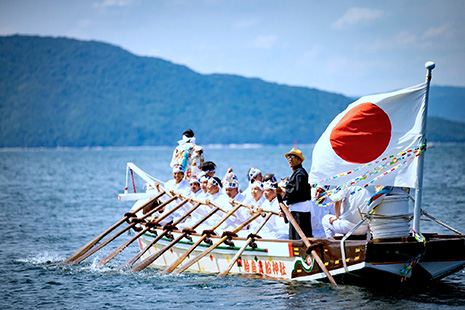
Photo: Sukumojima City Center
The island’s dwindling population has caused concern in recent years, but after the main mikoshi ceremony, you can also see a children’s mikoshi carried by children, who are expected to carry the main mikoshi someday, or to be the future rowers of the tenmasen boat.
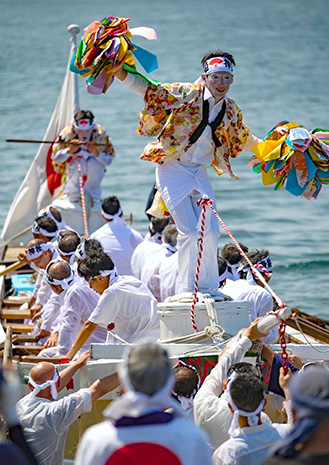
Photo: Sukumojima City Center
TAKAMATSU ended with some tips for visiting tourists on how to enjoy the festival. “On the day of the festival, islanders gather from their homes wearing in festival attire. On your visit, taking a commemorative photo with them will make a nice memory for you while also encouraging the islanders to continue the festival and look forward to more such interactions. The summer festival at Kifune Shrine has been passed down on the island through the generations. It is an important part of our culture, and our heartfelt wish is to again pass it on to the next generation.”

* A portable shrine in which the sacred object of worship of a god is placed and carried during festivals. It is said that the spirit of the deity, which usually resides in a shrine, temporarily rests in the mikoshi when it goes outside of the shrine.
** A fishing method in which a number of ropes with hooks are attached to a single long trunk rope and set in a certain depth of water. The sharp teeth of the pufferfish can chew through the rope, so the Sukumo Island fishermen devised a longline fishing method (called haenawa ryo) that uses steel wire. This became popular as a fishing method that can be used to harvest fresh pufferfish without damaging them.
*** Kifune Shrine is one of the shrines that enshrines the god of water, the source of life for all things. There are 2,000 such shrines in Japan.
**** A meaningless shout that is made when moving heavy objects.
BY TANAKA Nozomi
Photo: Tokuyama Plant, Nippon Seiro Co., Ltd.; Sukumojima City Center; PIXTA
